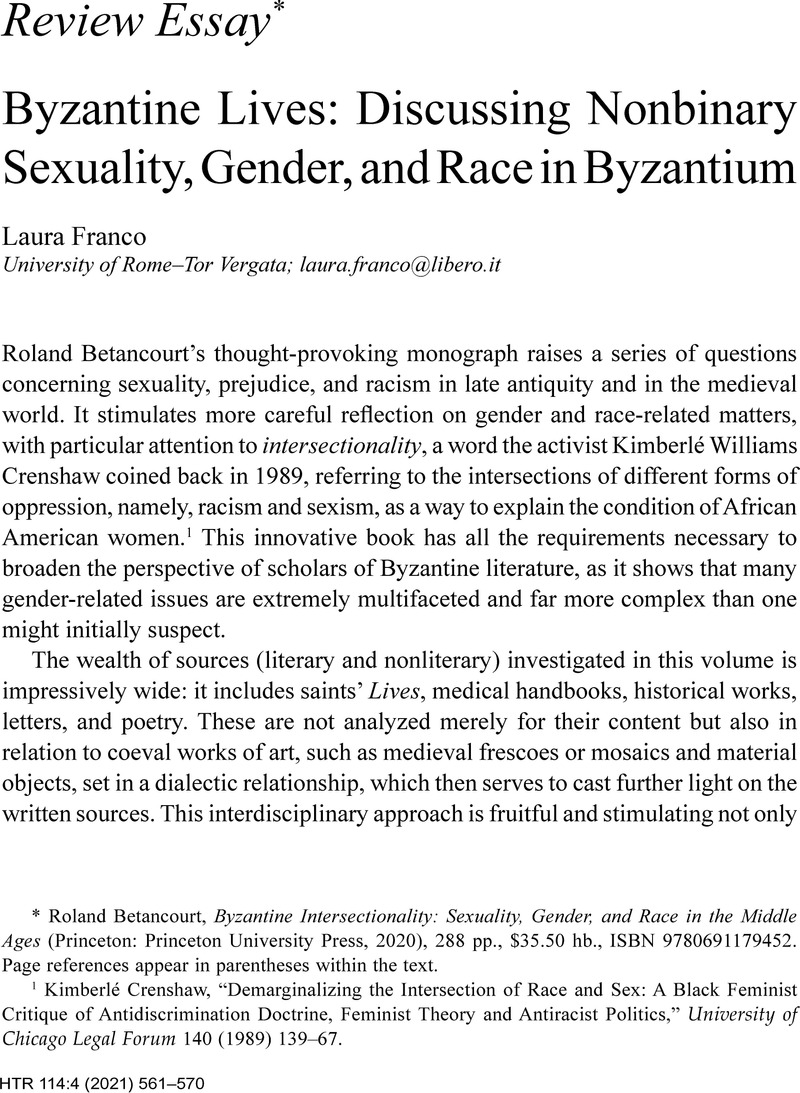Published online by Cambridge University Press: 10 November 2021

Roland Betancourt, Byzantine Intersectionality: Sexuality, Gender, and Race in the Middle Ages (Princeton: Princeton University Press, 2020), 288 pp., $35.50 hb., ISBN 9780691179452. Page references appear in parentheses within the text.
1 Kimberlé Crenshaw, “Demarginalizing the Intersection of Race and Sex: A Black Feminist Critique of Antidiscrimination Doctrine, Feminist Theory and Antiracist Politics,” University of Chicago Legal Forum 140 (1989) 139–67.
2 We may add that this element is particularly noteworthy, since individual choice is also a crucial philosophical concept as far as the decision of the faithful to profess the Christian faith is concerned, as it relates to the awareness in making the choice (προαίρεσις) of being a Christian. Already in Aristotle, Eth. Nic. 1111b–1112a, it is stressed that the concept of προαίρεσις differs from that of simple desire or will, as it implies the awareness of good and evil that distinguishes rational from irrational beings.
3 As Betancourt suggests, on the grounds that they belong to a nonbinary sexual identity.
4 See Arietta Papaconstantinou, “‘Je suis noire ma belle’. Le double langage de la Vie de Théodora d’Alexandrie, alias Abba Théodore,” Lalies 24 (2004) 63–86, esp. 77–78.
5 See Vincent Déroche, “Du rejet à l’adulation, de la vie scandaleuse au cult établi. Le paradox des saloi,” in Culte des saints et littérature hagiographique. Accords et désaccords (ed. Vincent Déroche, Bryan Ward-Perkins, and Robert Wiśniewski; Monographies du Centre de recherche d’histoire et civilisation de Byzance, Collège de France 55; Leuven: Peeters, 2020) 213–24.
6 On the concept of hidden sanctity as a literary topos, see the seminal article by Bernard Flusin, “Le serviteur caché ou le saint sans existence,” in Les “Vies des saints” à Byzance. Genre littéraire ou biographie historique? Actes du II e colloque international philologique, Paris 6-7-8 juin 2002 (Paris: Centre d’études byzantines, néo-helléniques et sud-est européennes, 2004) 59–71. And later, on Theodora of Alexandria, see Julie van Pelt, “Saints in Disguise: Performance in the Life of John Kalyvites (BHG 868), the Life of Theodora of Alexandria (BHG 1727) and the Life of Symeon Salos (BHG 1677),” in Storytelling in Byzantium: Narratological Approaches to Byzantine Texts and Images (ed. Charis Messis et al.; Studia Byzantina Upsaliensia 19; Uppsala, Sweden: Uppsala University, 2018) 137–57. On Daniel of Sketis, see Britt Dahlman, Saint Daniel of Sketis: A Group of Hagiographic Texts Edited with Introduction, Translation and Commentary (Uppsala, Sweden: Uppsala University, 2007), esp. 79–89.
7 On the theme of the scenes of recognition in hagiography, see Pascal Boulhol,Ἀναγνωρισμός. La scène de reconnaissance dans l’hagiographie antique et médiévale (Aix-en-Provence: Université de Provence, 1996).
8 Anatole Boucherie, Βίος καὶ πολιτεία τῆς ὁσίας Εὐφροσύνης καὶ τοῦ ταύτης πατρὸς Παφνουντίου in AB 2 (1883) 196–205 at 204 (my translation)
9 Even though it is undisputable that all these narratives are fictional, as Betancourt mentions (99), it cannot be denied that the practice of cross-dressing was more widespread than the texts alone may imply, as it seems to be implicit in imperial law codes and Church councils’ regulations prohibiting this practice.
10 One of the most cited works is J. P. Feighner, “Diagnostic Criteria for Use in Psychiatric Research,” Archives of General Psychiatry 26 (1972) 57–63. Amenorrhea is included among the six most common symptoms for diagnosing nervous anorexia.
11 A classic reading on this theme is Rudolph M. Bell, Holy Anorexia (Chicago: University of Chicago Press, 1985).
12 Gregory of Nissa, Vita Macrinae, in Gregorii Nysseni: Opera Ascetica (ed. Werner Jaeger, et al.; Leiden: Brill, 1952) 395 (ll. 20–21), 396 (ll.1–2) (=PG 46, 981D–984A).
13 Tertullian, Cult. Fem. 1.1, 2.
14 Boucherie, Βίος, 199–200 (my translation).
15 See, e.g., Averil Cameron, Christianity and the Rhetoric of Empire: The Development of Christian Discourse (Sather Classical Lectures 55; Berkeley: University of California Press, 1991), esp. 155–88.
16 Boucherie, Βίος, 204.